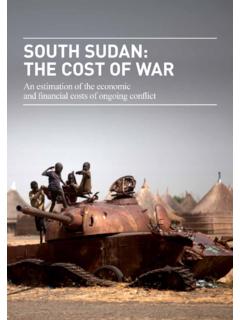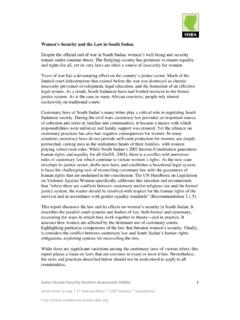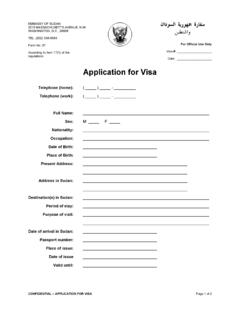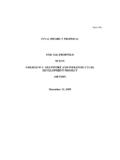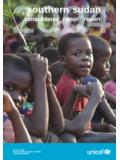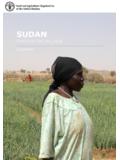Transcription of South Sudan Humanitarian Crisis Health …
1 Page | 0 South Sudan Humanitarian Crisis Health Emergency Response Funding Proposal Written and submitted by: WHO South Sudan February 2014 Page | 1 Project Summary 1. Project Title: Responding to Health -related Emergencies in Populations of Humanitarian Concern in the Republic of South Sudan 2. Country: South Sudan Beneficiary Population: 3. Date Contribution Received (month/year): Amount (US$): 11,134,000 4. Period of Implementation: Six months from 1 Feb 2014 Extension: 5. General Project Objective: To contribute the reduction of excess morbidity and mortality among displaced people and host communities affected by the current Crisis , through strengthening Health emergency preparedness and response capacity at all levels in South Sudan Project Purpose: 1. To ensure access to and delivery of quality primary and secondary Health care services through restoration and expansion of life-saving Health care services to affected population, with particular focus on the most vulnerable group.
2 2. To strengthen emergency preparedness and response capacity at all levels, and ensure availability of emergency medical kits and supplies in all high risk areas 3. To strengthen early warning diseases surveillance, information management and epidemic response among displaced people and other vulnerable groups through existing surveillance system 4. To improve and expand the overall Health cluster coordination mechanism at central and state levels for better coordination of Health emergency response activities in high risk areas and surrounding communities Page | 2 Table of Contents Project Summary .. 1 1. Background and 3 2. Health Situation .. 4 3. Current Response to the Humanitarian Crisis .. 6 4. Priority Needs and Response Strategy .. 7 5. The Proposal .. 9 Objectives .. 9 General Objective .. 9 Specific Objectives .. 9 Project Results .. 10 Expected outcomes .. 12 6 Monitoring and Evaluation .. 13 Indicators of progress.
3 14 7 Budget .. 15 Financial Implications .. 15 8 Annexes .. 18 Annex 1: Implementation timeline .. 18 Page | 3 1. Background and Overview South Sudan is facing its worst Humanitarian Crisis in many years, which is characterized by open internal conflict between government and opposition groups, major internal displacement and refugees, increasing food insecurity and high malnutrition rates, limited access to basic services and access challenges to Crisis affected areas. Humanitarian operations in South Sudan remain precarious, complex and uncertain. The current Humanitarian Crisis in South Sudan is widespread and severe, with more than million people in need of emergency assistance. The epicentre of the Humanitarian Crisis continues to be in Jonglei, Upper Nile, Unity states, due to the ongoing conflict. The country s very fragile Health system (lack of skilled staff, supplies, equipment and leadership at all levels) was negatively impacted by the Crisis , and further hampered the Humanitarian response.
4 Heavy fighting broke out in Juba on 15 December, 2013 with heavy gunfire and shelling in several parts of the city, and there after the violence spread to the neighbouring states of Jonglei, Unity, Upper Nile and Lakes. The fighting was orchestrated by the long standing political difference between the president and his former vice president, and later the president accused his former vice president and other opposition politicians of attempting to overthrow the government. South Sudan , which became an independent state on 9 July 2011, remains one of the poorest and least developed countries of the world, with less than 44% of the population have access to basic services1. Despite the signing of an agreement for the cessation of hostilities, the security situation across conflict affected areas continues to be tense and volatile. Clashes continue to be reported in the states of Jonglei, Unity, Lakes and Upper Nile, and access and delivery of Humanitarian assistance are becoming a major challenge.
5 These clashes have resulted in increased population displacement in major urban and rural areas in the conflict affected states, with the number of IDPs exceeding over 730,000. Of these IDPs, 76,100 are living in the UNMISS compound in Juba, Malakal, Bor and Bentiu, while another 91,700 are living in Awerial county in Lakes State close to Bor2. Nonetheless, it is estimated that the actual number of displaced people is far higher than recorded figure as the aid agencies estimating that over 1,900,000 thousand people may have been affected by the ongoing Crisis in conflict affected areas3. People continue to flee to neighbouring countries of Ugandan Kenya and Sudan , and over 150,000 South Sudanese sought refuge in neighbouring countries. The conflict has taken an ethnic dimension; mainly between the Nuer to which the former Vice President versus the Dinkas; the ethnic group of the President, and there may be a reoccurrence of retaliatory attacks especially in the three affected states.
6 1 Health Sector Development Plan 2011-2015 2 OCHA Humanitarian snapshot and Humanitarian report Feb 6 2014 3 Health Cluster Response Plan 2014 Page | 4 Table 1: Summary of overall displaced people per state in South Sudan State Number displaced CES 90,100 Upper Nile 100,800 Unity State 118,400 Jonglei 117,300 Lakes State 91,400 The overall Humanitarian situation among the displaced people has further deteriorated, and basic services including food, shelter, water and sanitation and Health are in great demand. Despite the diligent effort by the Humanitarian actors in the country to meet the basic necessities among displaced people, the living conditions inside and outside UN compounds is appalling. The displaced people are sheltering in makeshift and overcrowded camps with limited access to food, water or sanitation, and the risk of disease outbreaks is a serious concern.
7 In the past two weeks, more Humanitarian actors have returned into the county and are making efforts to respond to the Humanitarian Crisis by providing food, water Health and other essential services to the displaced people. Nonetheless, access to affected communities or counties is becoming a major challenge due to unpredictable security situation. 2. Health Situation The Health situation across South Sudan remains fragile, and the on-going Crisis has seriously impacting the Health service delivery. As the result of the on-going fighting and subsequent displacement, the Humanitarian need has risen as over million people have affected by the on-going Humanitarian Crisis and requires urgent Humanitarian assistance. Humanitarian needs among displaced people and other vulnerable groups continue to growth, and the Humanitarian operations in South Sudan remain precarious. Many of the displaced people due to the on-going fighting in greater Upper Nile states do not have access to life-saving primary Health care services among other basic services.
8 This is exacerbated by already very fragile Health systems (lack of skilled staff, supplies and equipment, leadership, etc. at all levels) that have further affected the Humanitarian response. Most of the Health facilities in Juba and affected states are almost non-functional as the Health personnel fail to report due to insecurity. Bor, Bentiu and Malakal State Hospitals and other primary Health care facilities were looted and not operational, while Juba hospital continues to be overwhelmed. The Ministry of Health has limited capacity to manage the current Health emergencies response and any public Health risks that may be of concern given this current Crisis . As the result of the deteriorating Humanitarian situation, there are still large-scale Humanitarian needs and the Health situation remains fragile with extremely low Health care coverage, high infant Page | 5 and under five mortality and morbidity rates. South Sudan has some of the worst Health indicators in the world with a Maternal Mortality Ratio of 2,054/100,000 live births and an Infant Mortality Rate of 102/1000 live births.
9 The national and state-specific immunization coverage surveys were conducted in 2012, and indicate that the age cohort (12-23 months) born in between December 2009 and November 2010 had a crude DTP-3 coverage of 54% (44-64% CI) compared to 63% reported in the same year. The immunization coverage surveys also showed that despite the good and comparable coverage, there remains poor card retention (40%), low card verified DTP-3 coverage ( ) and low proportion of fully immunized children by 1 year of age (13%). The measles virus is endemic in South Sudan and over the recent years, numerous measles outbreaks have been documented in many parts of the country. The routine EPI coverage is below 53%, while the measles coverage is less than 50%. In the last seven weeks, the Health situation across the country has further deteriorated, and over 75% of Health facilities in the counties of Jonglei, Unity and Upper Nile remain closed or not accessible to the affected population.
10 Preliminary assessments by the Health cluster indicates that three state hospitals and 25 Health facilities were vandalized during the Crisis , while many accessible service delivery points are operating at a minimum capacity. Due to the large number of displaced persons living inside the UN bases, there is limited and inadequate Health care services available for these displaced people, despite efforts by UNMISS clinics and Health cluster partners to beef up provision of primary Health care services. Health cluster partners are also having difficulties accessing existing Health facilities in areas affected by the on-going conflict, while severe shortage of life-saving drugs was also reported across the country. The displaced people living inside and outside the camps are at high risk of contracting communicable diseases due to poor sanitation, shortage of water, crowded living conditions, malnutrition, and poor immunity, with young children and pregnant women particularly vulnerable.










